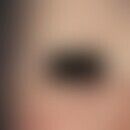Synonym(s)
DefinitionThis section has been translated automatically.
Rare, autosomal-dominant inherited, permanent, diffuse hairlessness (atrichia), often with missing nails.
EtiopathogenesisThis section has been translated automatically.
For AUC (as for Atrichia congenita with horny cysts = Papular Atrichia), mutations in the so-called hairless gene (HR gene) located on chromosome 8p21-p22 are detected. So far 1>50 mutations have been detected. Another gene that is also involved in the hair cycle is the vitamin D receptor (VDR) gene, which is located on chromosome 12q12-q14.
You might also be interested in
LocalizationThis section has been translated automatically.
scalp, eyebrows, eyelashes, nails
ClinicThis section has been translated automatically.
The hair falls out within the 1st year of life. Eyelashes, eyebrows and nails may also be missing. Papular lesions are conspicuous, which are typical for the clinical picture in addition to atrichia: These are located periorbital and in the knee region. Other anomalies are nail dystrophies, dental anomalies, skeletal anomalies and immunodeficiencies.
HistologyThis section has been translated automatically.
The infundibular parts of the hair follicles and sebaceous glands are normal, but hair shafts are missing. Instead, there are unstructured follicular horn masses.
Differential diagnosisThis section has been translated automatically.
Atrichia congenita with horny cysts; alopecia areata diffusa; syndromatic alopecia; ectodermal dysplasia;
Progression/forecastThis section has been translated automatically.
The hairlessness is permanent.
Note(s)This section has been translated automatically.
Congenital atrichia with severe T-cell defect and nail dystrophy (MIM 601705) is an independent clinical picture with a mutation in the WHN gene on chromosome 17.
LiteratureThis section has been translated automatically.
- Ahmad W et al (1998) Alopecia universalis associated with a mutation in the hairless gene. Science 279: 720-724
- Cichon S et al (1998) Cloning, genomic organization, alternative transcripts and mutational analysis of the gene responsible for autosomal recessive universal congenital alopecia. Hum Mol Genet 7: 1671-1679
- Betz RC (2014) Alopecia and hyoptrichosis in children. dermatologist 56: 520-526
- Klein I et al (2002) A novel missence mutation affecting the human hairless thyroid receptor interacting domain 2 causes congenital atrichia. J Invest Dermatol 119: 920-922
Outgoing links (3)
Alopecia areata diffusa; Atrichia congenita with horny cysts; Ectodermal dysplasia ;Disclaimer
Please ask your physician for a reliable diagnosis. This website is only meant as a reference.




